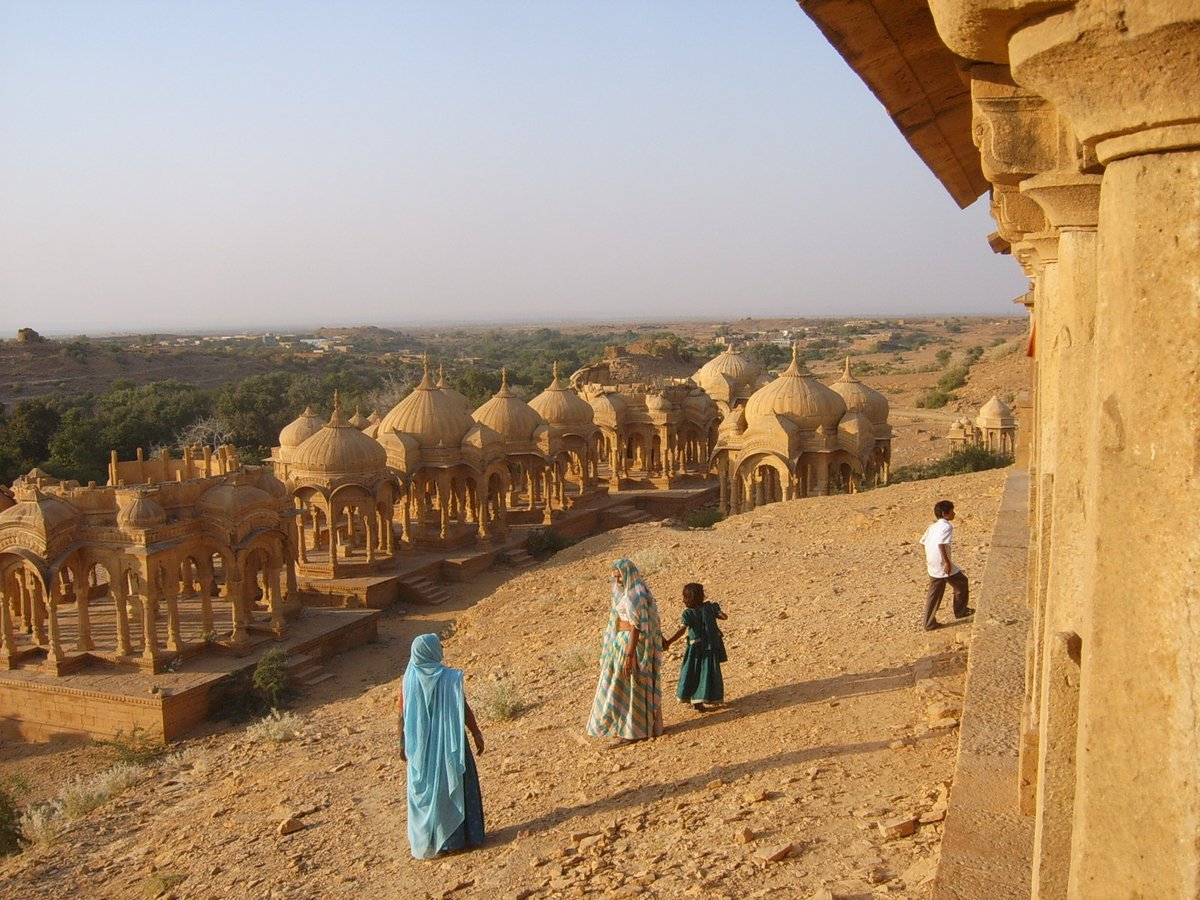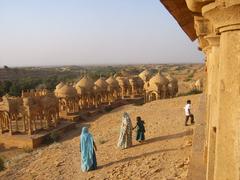
Comprehensive Guide to Visiting Bada Bagh, Jaisalmer, India
Date: 19/07/2024
Introduction
Nestled in the golden sands of Rajasthan, India, Bada Bagh is a historic garden complex approximately 6 kilometers north of Jaisalmer. Known as ‘Big Garden,’ this site holds immense historical and cultural significance as it bears witness to the rich legacy of the Jaisalmer royal family. Commissioned in the early 16th century by Maharawal Jait Singh, Bada Bagh began as a dam project aimed at addressing the water scarcity in the arid region. Over time, it transformed into a lush garden with intricately carved cenotaphs, or chhatris, constructed to honor the deceased members of the royal family (Rajasthan Tourism, Jaisalmer Tourism).
The cenotaphs at Bada Bagh stand as remarkable examples of Rajasthani architecture, showcasing a blend of Hindu and Mughal influences. Built using the region’s abundant yellow sandstone, each cenotaph features intricate carvings and inscriptions that offer a glimpse into the lives and achievements of the royal family. The architectural style, characterized by pyramid-like structures with central domes supported by elaborately carved pillars, reflects the craftsmanship of the era (Cultural India).
Despite facing neglect during the British colonial period, Bada Bagh has remained a cherished cultural and historical site. Recent restoration efforts by the Archaeological Survey of India (ASI) aim to preserve its architectural grandeur and historical significance for future generations. Today, Bada Bagh serves not only as a memorial but also as a popular tourist attraction, drawing visitors who come to admire its beauty and pay their respects (TripAdvisor).
Table of Contents
- [History of Bada Bagh](#history-of-bada-baghhistory-of-bada-bagh)
- [Origins and Construction](#origins-and-constructionorigins-and-construction)
- [Development Under Maharawal Lunkaran](#development-under-maharawal-lunkarandevelopment-under-maharawal-lunkaran)
- [Architectural Significance](#architectural-significancearchitectural-significance)
- [Historical Events and Changes](#historical-events-and-changeshistorical-events-and-changes)
- [Restoration Efforts](#restoration-effortsrestoration-efforts)
- [Cultural and Religious Significance](#cultural-and-religious-significancecultural-and-religious-significance)
- [Modern-Day Relevance](#modern-day-relevancemodern-day-relevance)
- [Visitor Information](#visitor-informationvisitor-information)
- [Visiting Hours](#visiting-hoursvisiting-hours)
- [Ticket Prices](#ticket-pricesticket-prices)
- [Guided Tours](#guided-toursguided-tours)
- [Best Photographic Spots](#best-photographic-spotsbest-photographic-spots)
- [Travel Tips](#travel-tipstravel-tips)
- [Nearby Attractions](#nearby-attractionsnearby-attractions)
- [Conclusion](#conclusionconclusion)
- [FAQ](#faqfaq)
History of Bada Bagh
Origins and Construction
Bada Bagh, which translates to ‘Big Garden,’ is a significant historical site located approximately 6 kilometers north of Jaisalmer, Rajasthan, India. The origins of Bada Bagh date back to the early 16th century when Maharawal Jait Singh, a ruler of Jaisalmer, commissioned the construction of a dam to create a water reservoir. This initiative was aimed at addressing the water scarcity issues in the arid region of Jaisalmer. The dam construction led to the creation of a lush garden, which was later named Bada Bagh.
Development Under Maharawal Lunkaran
The development of Bada Bagh continued under Maharawal Lunkaran, the son of Maharawal Jait Singh. Maharawal Lunkaran expanded the garden and initiated the construction of cenotaphs, known as chhatris, to honor the deceased members of the royal family. These cenotaphs are intricately carved and are a testament to the architectural prowess of the era. The first cenotaph was built in honor of Maharawal Jait Singh, who passed away in 1530. The tradition of constructing cenotaphs continued for several generations, making Bada Bagh a significant royal cremation ground.
Architectural Significance
The cenotaphs at Bada Bagh are remarkable examples of Rajasthani architecture. They are built using yellow sandstone, which is abundant in the region. Each cenotaph is unique, with intricate carvings and detailed inscriptions that provide insights into the lives and achievements of the royal family members. The cenotaphs are designed in a pyramid-like structure, with a central dome supported by intricately carved pillars. The architectural style reflects a blend of Hindu and Mughal influences, which was prevalent during the period.
Historical Events and Changes
Over the centuries, Bada Bagh has witnessed several historical events and changes. During the reign of Maharawal Jawahir Singh in the 18th century, the garden and cenotaphs were further expanded. However, the site faced neglect during the British colonial period, leading to the deterioration of some structures. Despite this, Bada Bagh remained an important cultural and historical site for the people of Jaisalmer.
Restoration Efforts
In recent years, efforts have been made to restore and preserve Bada Bagh. The Archaeological Survey of India (ASI) has undertaken several initiatives to maintain the site and protect it from further decay. These efforts include structural repairs, cleaning of the cenotaphs, and landscaping of the garden area. The restoration work aims to preserve the historical and architectural significance of Bada Bagh for future generations.
Cultural and Religious Significance
Bada Bagh holds immense cultural and religious significance for the people of Jaisalmer. The cenotaphs are not only memorials for the royal family but also serve as a symbol of the region’s rich heritage and history. The site is visited by locals and tourists alike, who come to pay their respects and admire the architectural beauty of the cenotaphs. Bada Bagh is also a popular spot for photography, especially during sunrise and sunset when the golden hues of the sandstone structures are accentuated by the natural light.
Modern-Day Relevance
Today, Bada Bagh is a prominent tourist attraction in Jaisalmer. It offers visitors a glimpse into the royal history and architectural grandeur of Rajasthan. The site is often included in guided tours of Jaisalmer, allowing tourists to explore the cenotaphs and learn about the historical significance of the site. Bada Bagh also serves as a venue for cultural events and festivals, further enhancing its relevance in contemporary times.
Visitor Information
Visiting Hours
Bada Bagh is open to visitors daily from 8:00 AM to 6:00 PM. It is advisable to visit early in the morning or late in the afternoon to avoid the harsh midday sun.
Ticket Prices
The entry fee for Bada Bagh is nominal, with separate charges for Indian and foreign tourists. Additional fees may apply for photography and videography.
Guided Tours
Guided tours are available for visitors who wish to gain deeper insights into the history and significance of Bada Bagh. These tours are often included in broader Jaisalmer tour packages.
Best Photographic Spots
Bada Bagh offers numerous picturesque spots, especially during sunrise and sunset. The golden light enhances the beauty of the sandstone cenotaphs, making it a perfect time for photography enthusiasts.
Travel Tips
- Best Time to Visit: The best time to visit is during the winter months (October to March) when the weather is pleasant.
- Dress Code: Wear comfortable footwear as the terrain can be uneven. Light, breathable fabrics such as cotton or linen are recommended.
- Hydration and Sun Protection: Carry water and sun protection, such as hats and sunscreen, due to the arid climate of the region.
Nearby Attractions
While visiting Bada Bagh, consider exploring other nearby attractions to make the most of your trip:
- Jaisalmer Fort: Also known as Sonar Quila, this UNESCO World Heritage Site is a must-visit (UNESCO).
- Patwon Ki Haveli: A cluster of five havelis with intricate architecture and historical significance.
- Sam Sand Dunes: Experience the Thar Desert with a camel safari or a jeep ride at the Sam Sand Dunes.
Conclusion
Bada Bagh stands as a testament to the rich history and architectural heritage of Jaisalmer. The cenotaphs, with their intricate carvings and historical significance, offer a unique insight into the royal legacy of Rajasthan. Efforts to preserve and restore the site ensure that Bada Bagh remains a cherished landmark for future generations to explore and appreciate.
For more detailed information on Bada Bagh, you can visit the official website of Rajasthan Tourism.
FAQ
What are the visiting hours of Bada Bagh?
Bada Bagh is open from 8:00 AM to 6:00 PM daily.
How much are the tickets for Bada Bagh?
The entry fee is nominal, with different charges for Indian and foreign tourists. Additional fees may apply for photography and videography.
What are the best times to visit Bada Bagh?
The best times to visit are early in the morning or late in the afternoon. The winter months (October to March) offer the most pleasant weather.
Are guided tours available at Bada Bagh?
Yes, guided tours are available and are often included in broader Jaisalmer tour packages.
What are the best photographic spots in Bada Bagh?
The best spots are during sunrise and sunset when the golden hues of the sandstone cenotaphs are most striking.
